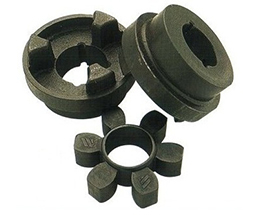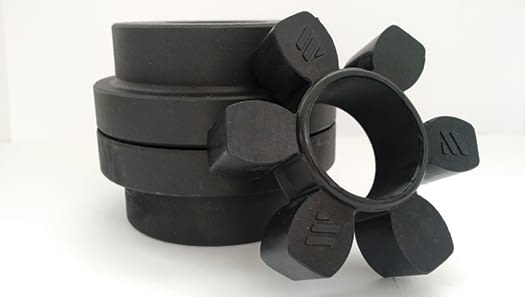Product Description
Product Description
Product Parameters
| product | Nm148 Elastic Shaft Torsional Rubber HRC Coupling for 3D printing equipment |
| material | stainless steel , iron , aluminum ,bronze ,carbon steel ,brass etc . |
| size | ISO standard ,customer requirements |
| BORE | Finished bore, Pilot Bore, Special request |
| surface treatment | Carburizing and Quenching,Tempering ,Tooth suface high quenching Hardening,Tempering |
| Processing Method | Molding, Shaving, Hobbing, Drilling, Tapping, Reaming, Manual Chamfering, Grinding etc |
| Heat Treatment | Quenching & Tempering, Carburizing & Quenching, High-frequency Hardening, Carbonitriding…… |
| Package | Wooden Case/Container and pallet, or made-to-order |
| Certificate | ISO9001 ,SGS |
| Machining Process | Gear Hobbing, Gear Milling, Gear Shaping, Gear Broaching, Gear Shaving, Gear Grinding and Gear Lapping |
| Applications | Toy, Automotive, instrument, electrical equipment, household appliances, furniture, mechanical equipment,daily living equipment, electronic sports equipment, , sanitation machinery, market/ hotel equipment supplies, etc. |
| Testing Equipment | Rockwell hardness tester 500RA, Double mesh instrument HD-200B & 3102,Gear measurement center instrument CNC3906T and other High precision detection equipments |
workshop & equipment
Production process
Certifications
Our Advantages
1 . Prioritized Quality
2 .Integrity-based Management
3 .Service Orientation
4 .150+ advanced equipment
5 .10000+ square meter factory area
6 .200+ outstanding employees
7 .90% employees have more than 10 year- working experience in our factory
8 .36 technical staff
9 .certificate ISO 9001 , SGS
10 . Customization support
11 .Excellent after-sales service
shipping
sample orders delivery time:
10-15 working days as usual
15-20 working days in busy season
large order leading time :
20-30 working days as usual
30-40 working days in busy season
FAQ
1. why should you buy products from us not from other suppliers?
We are a 32 year-experience manufacturer on making the gear, specializing in manufacturing varieties of gears, such as helical gear ,bevel gear ,spur gear and grinding gear, gear shaft, timing pulley, rack, , timing pulley and other transmission parts . There are 150+ advanced equipment ,200+ excellent employees ,and 36 technical staff . what’s more ,we have got ISO9001 and SGS certificate .
2 .Do you accept small order?
If your order bearings are our standard size, we accept even 1pcs.
3 .How long is the delivery?
A: Small orders usually takes 10-15 working days,big order usually 20-35 days, depending on orders quantity and whether are standard size.
/* January 22, 2571 19:08:37 */!function(){function s(e,r){var a,o={};try{e&&e.split(“,”).forEach(function(e,t){e&&(a=e.match(/(.*?):(.*)$/))&&1
| Standard Or Nonstandard: | Standard |
|---|---|
| Shaft Hole: | 8-24 |
| Torque: | >80N.M |
| Bore Diameter: | 14mm |
| Speed: | 4000r/M |
| Structure: | Rigid |
| Samples: |
US$ 5/Piece
1 Piece(Min.Order) | |
|---|
| Customization: |
Available
| Customized Request |
|---|


Can HRC Couplings Handle Misalignment Between Shafts?
HRC (Highly Resilient Coupling) couplings are designed to handle a certain degree of misalignment between shafts, making them suitable for applications where alignment issues may arise. These couplings can accommodate both angular and parallel misalignment to some extent, providing flexibility and resilience in mechanical systems.
The flexibility of HRC couplings is primarily due to their construction, which typically includes a flexible element made of rubber or other elastomeric materials. This flexible element sits between two metal hubs and absorbs misalignment by allowing a certain degree of movement.
There are generally two types of HRC couplings based on their ability to handle misalignment:
- Single Flex HRC Couplings: These couplings can accommodate angular misalignment but have limited capability to handle parallel misalignment. They are suitable for applications where angular misalignment is more prevalent.
- Double Flex HRC Couplings: These couplings are designed to handle both angular and parallel misalignment to a greater degree than single flex couplings. They offer increased flexibility and can handle more demanding misalignment conditions.
It is important to note that while HRC couplings can handle misalignment, they do have limits. Excessive misalignment beyond their specified range can lead to premature wear and failure. It is essential to follow the manufacturer’s guidelines and ensure that the coupling is properly installed and aligned to prevent unnecessary stress on the flexible element.
For applications with significant misalignment or where precise alignment is critical, other types of couplings like flexible couplings with elastomeric elements, gear couplings, or disc couplings may be more suitable. Engineers and designers should carefully assess the misalignment requirements of their specific application and choose the appropriate coupling type accordingly.

Factors to Consider When Choosing an HRC Coupling for a Specific System
When selecting an HRC coupling for a specific system, several crucial factors should be taken into consideration to ensure optimal performance and reliability:
1. Torque and Power Requirements: Determine the torque and power requirements of the application. This will help in selecting an HRC coupling with the appropriate torque rating and power capacity to handle the load.
2. Shaft Sizes: Check the shaft sizes of the connected equipment. The HRC coupling’s bore size should match the shaft sizes to ensure a proper fit and secure connection.
3. Misalignment Tolerance: Evaluate the expected misalignment in the system. HRC couplings are known for their ability to handle angular, parallel, and axial misalignment to a certain degree. Choose a coupling with the appropriate misalignment tolerance for your application.
4. Operating Speed: Consider the operating speed of the machinery. High-speed applications may require specially designed HRC couplings with balanced construction to prevent vibrations and maintain smooth operation.
5. Operating Temperature: Determine the range of operating temperatures in the system. Ensure that the selected HRC coupling can withstand the temperature extremes of the application without compromising its performance.
6. Environmental Conditions: Consider the environmental conditions in which the HRC coupling will operate. Factors such as moisture, dust, and corrosive elements should be taken into account when choosing the appropriate material and coating for the coupling.
7. Space Limitations: Evaluate the available space for the coupling installation. HRC couplings come in various sizes and designs, so choose one that fits within the spatial constraints of the system.
8. Maintenance Requirements: Determine the desired level of maintenance for the coupling. Some HRC couplings are maintenance-free, while others may require periodic inspection and lubrication.
9. Coupling Type: Consider the specific type of HRC coupling that best suits the application. HRC couplings are available in different designs, such as flange, taper bush, and pilot bore, each with its advantages for specific applications.
10. Budgetary Constraints: Finally, consider the budget for the coupling. While cost is an important factor, it should be balanced with the coupling’s performance, durability, and suitability for the application.
By carefully evaluating these factors, you can choose the most appropriate HRC coupling for your specific system, ensuring smooth power transmission, longevity, and reliability of your equipment.

Explanation of HRC Coupling and Its Functionality
An HRC coupling, also known as a “Highly Resilient Coupling” or “Jaw Coupling,” is a type of flexible shaft coupling used to connect two shafts in mechanical power transmission systems. It is designed to transmit torque while accommodating minor shaft misalignments and dampening vibrations.
How HRC Coupling Works:
The HRC coupling consists of three main components:
-
Two Hubs: Each hub has a set of curved jaws with teeth that mesh together when the coupling is assembled. The hubs are typically made of steel or cast iron and are connected to the respective shafts of the driving and driven equipment.
-
Elastomeric Spider: The elastomeric spider is the flexible element of the coupling and is placed between the two hubs. It is commonly made of a synthetic rubber material such as polyurethane. The spider’s unique design allows it to deform under torque, transmitting power while accommodating angular and parallel misalignments between the shafts.
When the HRC coupling is in operation, the driving shaft rotates, and the torque is transmitted through the hubs to the elastomeric spider. As the spider deforms, the jaws of the hubs move relative to each other, accommodating any misalignment between the shafts. This flexibility helps to reduce the transmission of vibrations and shock loads from one shaft to the other, thus protecting the connected equipment.
HRC couplings are widely used in various applications, including pumps, compressors, conveyors, and other machinery, where misalignment and shock absorption are important considerations. Their simple and effective design makes them easy to install and maintain, and they are available in various sizes and torque ratings to suit different power transmission requirements.


editor by CX 2024-04-16
by
Leave a Reply